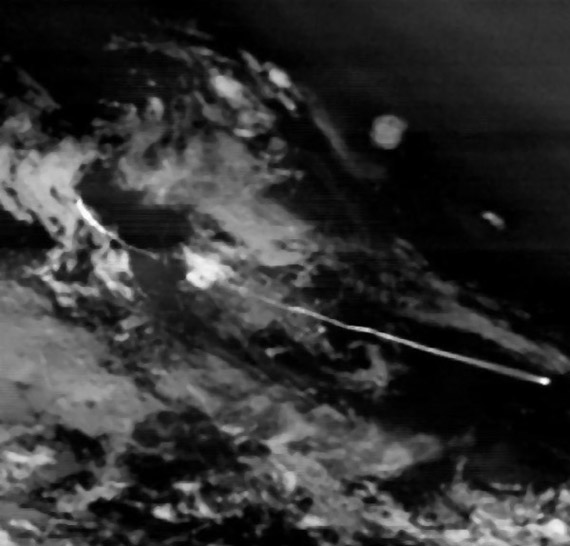This post has been updated as of 4:02 pm on Friday.
Sometimes you see a picture that is simply so amazing you have trouble believing it is real. That was the case with two images the Air Force released from its SBIRS–HEO on-orbit checkout.
I found them so amazing on so many different levels!
My first reaction was incredulity. My experience with the Department of Defense’s attitude toward missile warning satellites dates to when I worked at the Congressional Budget Office in 1998. I called the officer (a Navy Captain) in charge of the Defense Support Program (the early warning satellite SBIRS is replacing) and he denied having ever hear of DSP and cast doubt on its existence. (How’s that for the silent service! After all, DSP had been known and talked about in public since the 1991 Gulf War.) Now, the Air Force is releasing actual images taken by SBIRS and they are plastered all across Aviation Leak (Amy Butler, Pentagon Turns On First Sbirs Sensor,
November 20, 2006, p22) and the internet. What is the world coming to?
My second reaction was: this is a really impressive sensor! My third was: am I sure this was the infrared sensor? Could it have been a visible light sensor that is run in parallel with the infrared one? But after I thought about it a bit, I have become convinced that this was the primary infrared sensor. And wow, what a sensor!
Besides a lingering doubt that the Air Force would really release these photos if they were the real McCoy, the clouds seemed—at first glance—too bright and I also think I can see to the ground on the image taken on November 4, 2006. (See the image published in AvLeak.)

But (and it’s a big but) the background in these photos have been integrated for at least 100 seconds and probably for over 200 seconds, while the signals have not. The clouds in the November 4th 2006 image (of a Delta IV M launch) are close to being aligned for specular reflection (which is why they are so bright) and the 11 June 2008 image (of a Delta II) was taken around local noon. And yet, even though the signal is not “integrated,” it appears almost as bright as the brightest of the brightest clouds. That means that the signal to noise to noise ratio is at least several hundred to one even before sophisticated background subtraction schemes are applied, at least for these very large boosters.
On Monday, I will talk more about analyzing these images and the phenomenology of observing rocket plumes from space. Oh, yes, this might be another series of posts!
But until then: Wow, what a detector!


What’s even more surprising is that satellite on which the sensor’s hosted is an NRO ELINT bird (TRUMPET follow-on) in Molniya orbit. And the two images provide information that can be used to constrain the host’s orbital elements. The NRO of old would have had a collective stroke at the idea.
Actually, the amateur network of satellite observers have not only already identified the satellites these images were taken from (USA 184 and 200) but have already determined their orbital elements. My blogs next week will use that information in the analysis, but I’m jumping ahead.
> amateur
Yes, I subscribe to SeeSat-L too. But the NRO of yore operated in a reality-free zone when it came to such matters.
Amazing indeed on so many levels!
I think the signal HAS been integrated though. It is bright when the missile is slow, it contains what looks like a ‘staging event’ and is bright again as it climbs above the heaviest atmosphere. It looks like a record of about 3 minutes (200sec)of flight.
I don’t see how the background could be integrated without the signal also — or do you simply mean that the signal was moving in the FoV?
It’s hard to deduce much without knowing the frame-times of the CCDs. I think the real breakthrough would be in being able to have rapid flush times for large format CCDs — any info on that re. SBIRS?
The images are impressive, but par for the course given current CCDs — the MSX and SPITZER observatory IR images were/are impressive as well.
Yes, that’s exactly what I mean. (Isn’t that obvious? After all, as we shall see in the next couple of days, that’s not a contrail, that’s the image of the exhaust plume streaking across the Earth’s surface.) The rocket is moving across the field of view while the background remains more or less stationary for several hundred seconds. Let’s discuss how impressive it is after my next couple of posts. Right now, I remain very impressed.